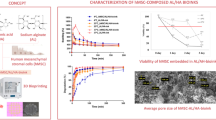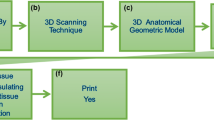Abstract
A major roadblock in the development of tissue engineered vascular grafts (TEVGs) is achieving construct endothelialization that is stable under physiological stresses. The aim of the current study was to validate an approach for generating a mechanically stable layer of endothelial cells (ECs) in the lumen of TEVGs. To accomplish this goal, a unique method was developed to fabricate a thin EC layer using poly(ethylene glycol) diacrylate (PEGDA) as an intercellular “cementing” agent. This EC layer was subsequently bonded to the lumen of a tubular scaffold to generate a bi-layered construct. The viability of bovine aortic endothelial cells (BAECs) through the “cementing” process was assessed. “Cemented” EC layer expression of desired phenotypic markers (AcLDL uptake, VE-cadherin, eNOS, PECAM-1) as well as of injury-associated markers (E-selectin, SM22α) was also examined. These studies indicated that the “cementing” process allowed ECs to maintain high viability and expression of mature EC markers while not significantly stimulating primary injury pathways. Finally, the stability of the “cemented” EC layers under abrupt application of high shear pulsatile flow (~11 dyn/cm2, P avg ~ 95 mmHg, ΔP ~ 20 mmHg) was evaluated and compared to that of conventionally “seeded” EC layers. Whereas the “cemented” ECs remained fully intact following 48 h of pulsatile flow, the “seeded” EC layers delaminated after less than 1 h of flow. Furthermore, the ability to extend this approach to degradable PEGDA “cements” permissive of cell elongation was demonstrated. Combined, these results validate an approach for fabricating bi-layered TEVGs with stable endothelialization.







Similar content being viewed by others
References
Bryant, S. J., and K. S. Anseth. Hydrogel properties influence ECM production by chondrocytes photoencapsulated in poly(ethylene glycol) hydrogels. J. Biomed. Mater. Res. 59:63–72, 2002.
Bryant, S. J., and K. S. Anseth. Controlling the spatial distribution of ECM components in degradable PEG hydrogels for tissue engineering cartilage. J. Biomed. Mater. Res. A 64A:70–79, 2003.
Bryant, S. J., K. S. Anseth, D. A. Lee, and D. L. Bader. Crosslinking density influences the morphology of chondrocytes photoencapsulated in PEG hydrogels during the application of compressive strain. J. Orthop. Res. 22:1143–1149, 2004.
Bryant, S. J., K. L. Durand, and K. S. Anseth. Manipulations in hydrogel chemistry control photoencapsulated chondrocyte behavior and their extracellular matrix production. J. Biomed. Mater. Res. A 67A:1430–1436, 2003.
Bulick, A. S., D. J. Muñoz-Pinto, X. Qu, M. Mani, D. Cristancho, M. Urban, and M. S. Hahn. Impact of endothelial cells and mechanical conditioning on smooth muscle cell extracellular matrix production and differentiation. Tissue Eng. A 15:815–825, 2009.
Chaudhuri, V., and M. A. Karasek. Mechanisms of microvascular wound repair ii. Injury induces transformation of endothelial cells into myofibroblasts and the synthesis of matrix proteins. In Vitro Cell. Dev. Biol. Animal 42:314–319, 2009.
Fung, Y. C. Biomechanics: Mechanical Properties of Living Tissues (2nd ed.). New York: Springer-Verlag, pp. 321–391, 1993.
Hahn, M., M. McHale, E. Wang, R. Schmedlen, and J. West. Physiologic pulsatile flow bioreactor conditioning of poly(ethylene glycol)-based tissue engineered vascular grafts. Ann. Biomed. Eng. 35:190–200, 2007.
Hahn, M., L. Taite, J. Moon, M. Rowland, K. Ruffino, and J. West. Photolithographic patterning of polyethylene glycol hydrogels. Biomaterials 27:2519–2524, 2006.
Hastings, N. E., M. B. Simmers, O. G. McDonald, B. R. Wamhoff, and B. R. Blackman. Atherosclerosis-prone hemodynamics differentially regulates endothelial and smooth muscle cell phenotypes and promotes pro-inflammatory priming. Am. J. Physiol. Cell Physiol. 293:C1824–C1833, 2007.
Hiles, M., S. Badylak, G. Lantz, K. Kokini, L. Geddes, and R. Morff. Mechanical properties of xenogeneic small-intestinal submucosa when used as an aortic graft in the dog. J. Biomed. Mater. Res. 29:883–891, 1995.
Hummon, A. B., S. R. Lim, M. J. Difilippantonio, and T. Ried. Isolation and solubilization of proteins after trizol extraction of RNA and DNA from patient material following prolonged storage. Biotechniques 42:467–472, 2007.
Isenberg, B., and R. Tranquillo. Long-term cyclic distention enhances the mechanical properties of collagen-based media-equivalents. Ann. Biomed. Eng. 31:937–939, 2003.
Johnson, C., T. How, M. Scraggs, C. West, and J. Burns. A biomechanical study of the human vertebral artery with implications for fatal arterial injury. Forensic Sci. Int. 109:169–182, 2000.
Lemson, M. S., J. H. M. Tordoir, M. J. A. P. Daemen, and P. J. E. H. M. Kitslaar. Intimal hyperplasia in vascular grafts. Eur. J. Vasc. Endovasc. Surg. 19:336–350, 2000.
Lloyd-Jones, D., R. Adams, M. Carnethon, G. De Simone, T. B. Ferguson, K. Flegal, E. Ford, K. Furie, A. Go, K. Greenlund, N. Haase, S. Hailpern, M. Ho, V. Howard, B. Kissela, S. Kittner, D. Lackland, L. Lisabeth, A. Marelli, M. McDermott, J. Meigs, D. Mozaffarian, G. Nichol, C. O’Donnell, V. Roger, W. Rosamond, R. Sacco, P. Sorlie, R. Stafford, J. Steinberger, T. Thom, S. Wasserthiel-Smoller, N. Wong, J. Wylie-Rosett, Y. Hong, AHA Statistics Committee, and Stroke Statistics Subcommittee. Heart disease and stroke statistics—2009 update: a report from the American Heart Association Statistics Committee and Stroke Statistics Subcommittee. Circulation 119:e21–e181, 2009.
McKee, J. A., S. S. R. Banik, M. J. Boyer, N. M. Hamad, J. H. Lawson, L. E. Niklason, and C. M. Counter. Human arteries engineered in vitro. EMBO J. 4:633–638, 2003.
Peyton, S., C. Raub, V. Keschrumrus, and A. Putnam. The use of poly(ethylene glycol) hydrogels to investigate the impact of ECM chemistry and mechanics on smooth muscle cells. Biomaterials 27:4881–4893, 2006.
Posey, J., and L. Geddes. Measurement of the modulus of elasticity of the arterial wall. Cardiovasc. Res. Ctr. Bull. 11:83–88, 1973.
Raeber, G. P., M. P. Lutolf, and J. A. Hubbell. Molecularly engineered peg hydrogels: a novel model system for proteolytically mediated cell migration. Biophys. J. 89:1374–1388, 2005.
Reddy, S. K., R. P. Sebra, K. S. Anseth, and C. N. Bowman. Living radical photopolymerization induced grafting on thiol-ene based substrates. J. Polym. Sci. A 43:2134–2144, 2005.
Rinker, K. D., A. P. Kirkpatrick, H. P. Ting-Beall, R. D. Shepherd, J. D. Levin, J. Irick, J. L. Thomas, and G. A. Truskey. Linoleic acid increases monocyte deformation and adhesion to endothelium. Atherosclerosis 177:275–285, 2004.
Rydholm, A. E., K. S. Anseth, and C. N. Bowman. Effects of neighboring sulfides and pH on ester hydrolysis in thiol-acrylate photopolymers. Acta Biomater. 3:449–455, 2007.
Salacinski, H., A. Tiwari, G. Hamilton, and A. Seifalian. Cellular engineering of vascular bypass grafts: role of chemical coatings for enhancing endothelial cell attachment. Med. Biol. Eng. Comput. 39:609–618, 2001.
Sawhney, A., C. Pathak, and J. Hubbell. Bioerodible hydrogels based on photopolymerized poly(ethylene glycol)-copoly(alpha-hydroxy acid) diacrylate macromers. Macromolecules 26:581–587, 1993.
Schmedlen, R. H., W. M. Elbjeirami, A. S. Gobin, and J. L. West. Tissue engineered small-diameter vascular grafts. Clin. Plast. Surg. 30:507–517, 2003.
Seliktar, D., R. Black, R. Vito, and R. Nerem. Dynamic mechanical conditioning of collagen-gel blood vessel constructs induces remodeling in vitro. Ann. Biomed. Eng. 28:351–362, 2000.
Solan, A., S. Mitchell, M. Moses, and L. Niklason. Effect of pulse rate on collagen deposition in the tissue-engineered blood vessel. Tissue Eng. 9:579–586, 2003.
Soulis, J. V., T. M. Farmakis, G. D. Giannoglou, and G. E. Louridas. Wall shear stress in normal left coronary artery tree. J. Biomech. 39:742–749, 2006.
Thompson, M., J. Budd, S. Eady, R. James, and P. Bell. Effect of pulsatile shear stress on endothelial attachment to native vascular surfaces. Br. J. Surg. 81:1121–1127, 1994.
Wechezak, A. R., D. E. Coan, R. F. Viggers, and L. R. Sauvage. Dextran increases survival of subconfluent endothelial cells exposed to shear stress. Am. J. Physiol. Heart Circ. Physiol. 264:H520–H525, 1993.
West, J. L., and J. A. Hubbell. Separation of the arterial wall from blood contact using hydrogel barriers reduces intimal thickening after balloon injury in the rat: the roles of medial and luminal factors in arterial healing. Proc. Natl Acad. Sci. USA 93:13188–13193, 1996.
West, J., and J. Hubbell. Polymeric biomaterials with degradation sites for proteases involved in cell migration. Macromolecules 32:241–244, 1999.
Wolf, S., and N. Werthessen. Dynamics of Arterial Flow. New York: Plenum Press, p. 472, 1979.
Womersley, J. R. Method for the calculation of velocity, rate of flow and viscous drag in arteries when the pressure gradient is known. J. Physiol. 127:553–563, 1955.
Womersley, J. Oscillatory flow in arteries: the constrained elastic tube as a model of arterial flow and pulse transmission. Phys. Med. Biol. 2:178, 1957.
Zhang, Z.-X., T.-F. Xi, Y.-J. Wang, X.-S. Chen, J. Zhang, C.-R. Wang, Y.-Q. Gu, L. Chen, J.-X. Li, and B. Chen. In vitro study of endothelial cells lining vascular grafts grown within the recipient’s peritoneal cavity. Tissue Eng. A 14:1109–1120, 2008.
Acknowledgments
The authors would like to acknowledge funding from the Texas Engineering Experimental Station. We also acknowledge the lab of Victor Ugaz, PhD for use of their viscometer.
Author information
Authors and Affiliations
Corresponding author
Additional information
Associate Editor Kyriacos A. Athanasiou oversaw the review of this article.
Rights and permissions
About this article
Cite this article
Jimenez-Vergara, A.C., Guiza-Arguello, V., Becerra-Bayona, S. et al. Approach for Fabricating Tissue Engineered Vascular Grafts with Stable Endothelialization. Ann Biomed Eng 38, 2885–2895 (2010). https://doi.org/10.1007/s10439-010-0049-8
Received:
Accepted:
Published:
Issue Date:
DOI: https://doi.org/10.1007/s10439-010-0049-8




